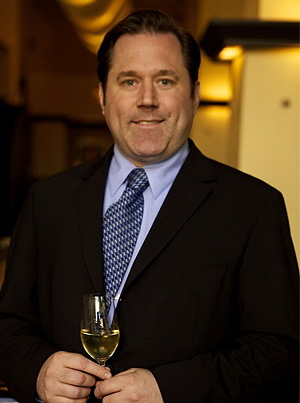

You list Evening Land’s Eola Amity Hills Gotham Cuvée as your top selling wine. Is that because it’s Oregon pinot noir, or because it’s a special bottling for your restaurant?
The Evening Land was on the list before I started and I’ve continued with that blend—an Evening Lands made-to-order wine. It’s a good concept for them. The fact that it’s Oregon…that it meets a rich, ripe flavor profile but still has structure…that they’re pulling back on the oak regimen is key. That’s been a limiting factor for me getting behind Oregon pinots. The wines show some of the best potential for New World pinot, but people screw them up with overripe grapes or too much oak. The Evening Lands appeals to people looking for a bigger, richer pinot, but it isn’t effected by oak so works well with food.
Second place goes to a Rioja—a 2001 Gran Reserva from La Rioja Alta. Has Rioja always been strong at Gotham?
Well, the key was price. If I were to have a $75 California cabernet on the list, that would be number one. But I’m pretty picky with California cabernet in that price range. I’ve been keeping it at $100. Richard Betz had made one, his CC: Cabernet from Napa, we had that on for $75, but they ran out of it. For a certain demographic, that price is appealing. The Rioja is big and full-bodied, but not super big due to its age. People don’t often pick it out. They’ll ask for a wine under $100 and a big, full-bodied red, that’s one of the wines we’ll go to. People are willing to try something new that still fits the flavor profile. Half bottles of it sell great as well.
I’m surprised to see Kistler’s Russian River Pinot Noir so high up on your list. Is style driving that or name recognition?
Nine times out of ten, people are saying, “I didn’t realize they made pinot, I’m only familiar with their chardonnays.” Personally, I’ve always had a preference for their pinots over their chardonnays. I have thirty pinot noir selections up and down the coast of California, all different styles and price points. Kistler’s where people go if they want something a little decadent, a little rich. We’re selling it to them by their description.
Your top-selling list is strong in Napa Valley cabernet, with three out of the top ten.
To some degree, those wines are similar in style—the style people are looking for—but each at a particular price point. I haven’t been able to find a really great Napa cabernet to list for under $100. The Hobbs Crossbarn works. 2009 is what we’re doing now and some people have the impression that it’s too young. People aren’t ready to drink ’09 yet. That’s one reason they might go to the Ramey. It’s a little herbaceous, not as much primary fruit as the Crossbarn. The Leviathan is the wine when people want that Napa cabernet but also want something adventurous, out of the ordinary, at comfortable price point—$125—that’s our go to. It’s been wildly successful. It speaks to California as far as ripeness, but also has some structure, toned back by the syrah in the blend—there’s a fair amount of syrah, which I would have never guessed blind. That’s what I tell people. Even if they’re dubious at first, the wine wins them over in the end.
Did you intentionally choose a Greek wine—Skouras Nemea—as the least expensive wine on the list?
Well, no. For better or worse, I’m not super analytical about how things fall in terms of price point. It just so happened that I liked the wine; I thought it was delicious, so I put it on the list. I know there’s that common psychology—you put things on at a low price so people feel comfortable paying $50 for something else. That’s not how I think about it. Greek wines are great and represent great value: You’d be hard pressed to find a better value with food in the world. Sadly, because it is the lowest priced wine on the list, we don’t get a lot of action on it.
How did prosecco rise to your top-selling sparkling wine by the glass?
We have four different sparklers at four price points: prosecco, a sparkling pinot from Argentina and two proper Champagnes, a Blanc de Blancs and Rosé. The prosecco was the most affordable of the four (until I dropped the price on the wine from Argentina). The Champagnes are $24 and $27 a glass. This is $13. People know prosecco and they love it. There are so many Italian restaurants in New York City; now prosecco has become a very common wine everywhere.
Have you noticed any trend in style preferences this past year?
The biggest trend of the year for me is in white wine: Now I sell more Central Coast and Anderson Valley chardonnay than Napa and Sonoma chardonnay. When you look at the new Dumuth Vineyards chardonnays, or if you get chardonnays from Santa Barbara and Monterey. Figge is a wine we do well with. People don’t want the blown out by chardonnay. They want something that’s rich, but not just about fruit. We do well with Au Bon Climat for that reason. People are talking about wines that are brighter, crisper, with less oak. It’s one thing to talk the talk. But once you’ve ordered the wine and you’re drinking it, you’ve got to like it.
That dialing back isn’t happening as much with reds. People may be going from a Napa cabernet to a rich pinot noir, so the variety may be lighter, but the style is not. Even so, people are definitely looking outside California for pinot noir choices, not only domestically. More and more, people are at least thinking about Burgundy.
Joshua Greene is the editor and publisher of Wine & Spirits magazine.
















